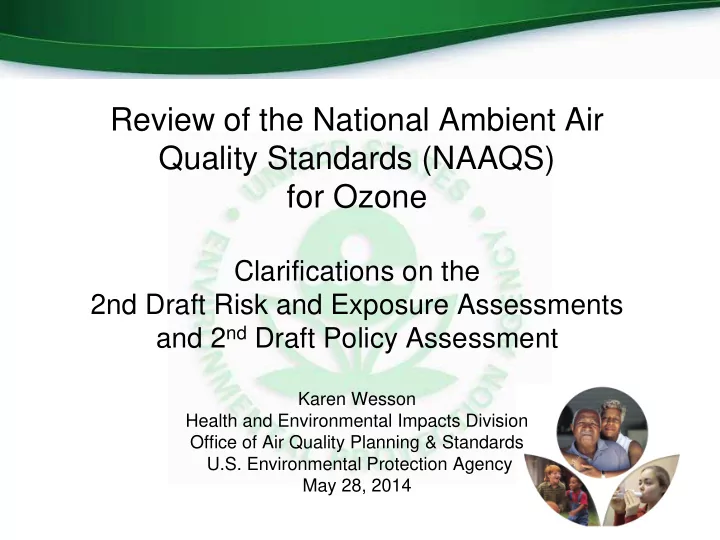

Review of the National Ambient Air Quality Standards (NAAQS) for Ozone Clarifications on the 2nd Draft Risk and Exposure Assessments and 2 nd Draft Policy Assessment Karen Wesson Health and Environmental Impacts Division Office of Air Quality Planning & Standards U.S. Environmental Protection Agency May 28, 2014
Discussion Outline • Materials Provided to CASAC since March 25-27, 2014 CASAC Meeting – Health Risk and Exposure Assessment (HREA) • Corrections to Epidemiology-based Risk Estimates • Long-term Ozone Exposure Related Mortality Threshold Sensitivity Analysis – Welfare Risk and Exposure Assessment (WREA) • Additional Information on Biomass Loss Function • Technical Information on Relationship between 1-Year Average and 3-Year Average W126 Levels • Clarification Questions Regarding CASAC’s Advice on the Policy Assessment (PA) 2
HREA: Corrections to Epidemiology-based Risk Estimates • Prior to the March 25-27, 2014 CASAC Ozone Review Panel meeting, a public commenter identified an error in EPA’s epidemiology-based risk estimates as reported in Chapter 7 and related appendices of the HREA • CASAC requested that EPA provide corrected estimates with documentation no later than one month prior to the May 28, 2014 Panel teleconference • EPA identified the cause of the errors, and in an April 28, 2014 memorandum EPA documented that cause and the solution to the errors, and provided revised HREA Chapter 7 tables incorporating corrected risk estimates • After receiving the corrected Chapter 7 risk estimates, CASAC requested that EPA also provide corrected versions of the Chapter 7 appendices – on May 9, 2014 EPA provided corrected appendices to CASAC 3
HREA: Long-term Ozone Exposure Related Mortality Threshold Sensitivity Analysis • A public commenter recommended that EPA evaluate the impact of using a threshold model on mortality risks associated with long-term ozone concentrations • CASAC requested that EPA include such an evaluation as a sensitivity analysis to supplement the core long-term mortality risk results for the final HREA • EPA contacted the study authors to request clarification regarding the threshold model and to obtain additional information required to conduct the sensitivity analysis • On April 28, 2014 , EPA provided CASAC a memorandum documenting the response to this request and the Agency’s plans for the sensitivity analysis to be included in the final HREA • The memorandum also provided EPA’s interpretation that inclusion of the sensitivity analysis would not affect the conclusions of the Policy Assessment 4
WREA: Additional Information on Biomass Loss Function and 1-Year vs. 3-Year Averages • On April 28, 2014 , EPA provided CASAC with documentation by email clarifying the three approaches used to develop median tree seedling biomass loss functions • On April 22, 2014 , EPA provided CASAC with a 2010 draft technical analysis based on 2007-2009 data regarding the relationship between the 1-year average and 3-year average W126 levels • In a subsequent May 7, 2014 memorandum, EPA clarified that this analysis was updated in Appendix 2C of the 2 nd draft Policy Assessment, which provided new information about the relationship between the 1- and 3-year average W126 levels based on more recent data 5
Clarification Questions on Policy Assessment: Primary Standard • As the Panel further develops its recommendations on the range of levels for the primary standard, EPA encourages the continued refinement of the underlying scientific rationales and judgments. EPA particularly encourages the Panel to clarify how it views the various elements of the scientific evidence and exposure/risk information, including important uncertainties and limitations. For example, what are the Panel’s views on: The potential public health significance of ozone-induced FEV1 decrements ≥ 10, 15, 20 %, in – light of CASAC’s previous advice? • The public health protection afforded by standard levels from 70 to 60 ppb given the estimated lower number of occurrences of ozone-induced lung function decrements, relative to the current standard? – The adversity and potential public health significance of single and multiple exposures of concern to ozone concentrations at or above 60, 70, and 80 ppb benchmarks, especially with respect to at-risk populations, given the evidence from controlled human exposure studies conducted with healthy adults? • The public health protection afforded by standard levels from 70 to 60 ppb given the estimated lower number of occurrences of exposures of concern, relative to the current standard? – The appropriate interpretation of the available epidemiologic evidence within the context of 6 considering potential alternative standard levels from 70 to 60 ppb?
Clarification Questions on Policy Assessment: Secondary Standard • As the Panel further develops its recommendations on the range of levels for the secondary standard, EPA encourages the continued refinement of the underlying scientific rationales and judgments. EPA particularly encourages the Panel to clarify how it views the various elements of the scientific evidence and exposure/risk information, including important uncertainties and limitations. For example, what are the Panel’s views on: – The Panel cites one study (Wittig et al, 2009) and a consensus meeting (Heck and Cowling, 1997) as providing support for 2% relative biomass loss in trees as a benchmark for adverse impact on trees. Could the Panel please clarify how they are interpreting these studies to support this benchmark and if there are additional studies that provide this support? – The factors to consider in evaluating the potential public welfare significance of effects of concern and how these factors relate to the recommended range of levels for the secondary standard? 7
Recommend
More recommend